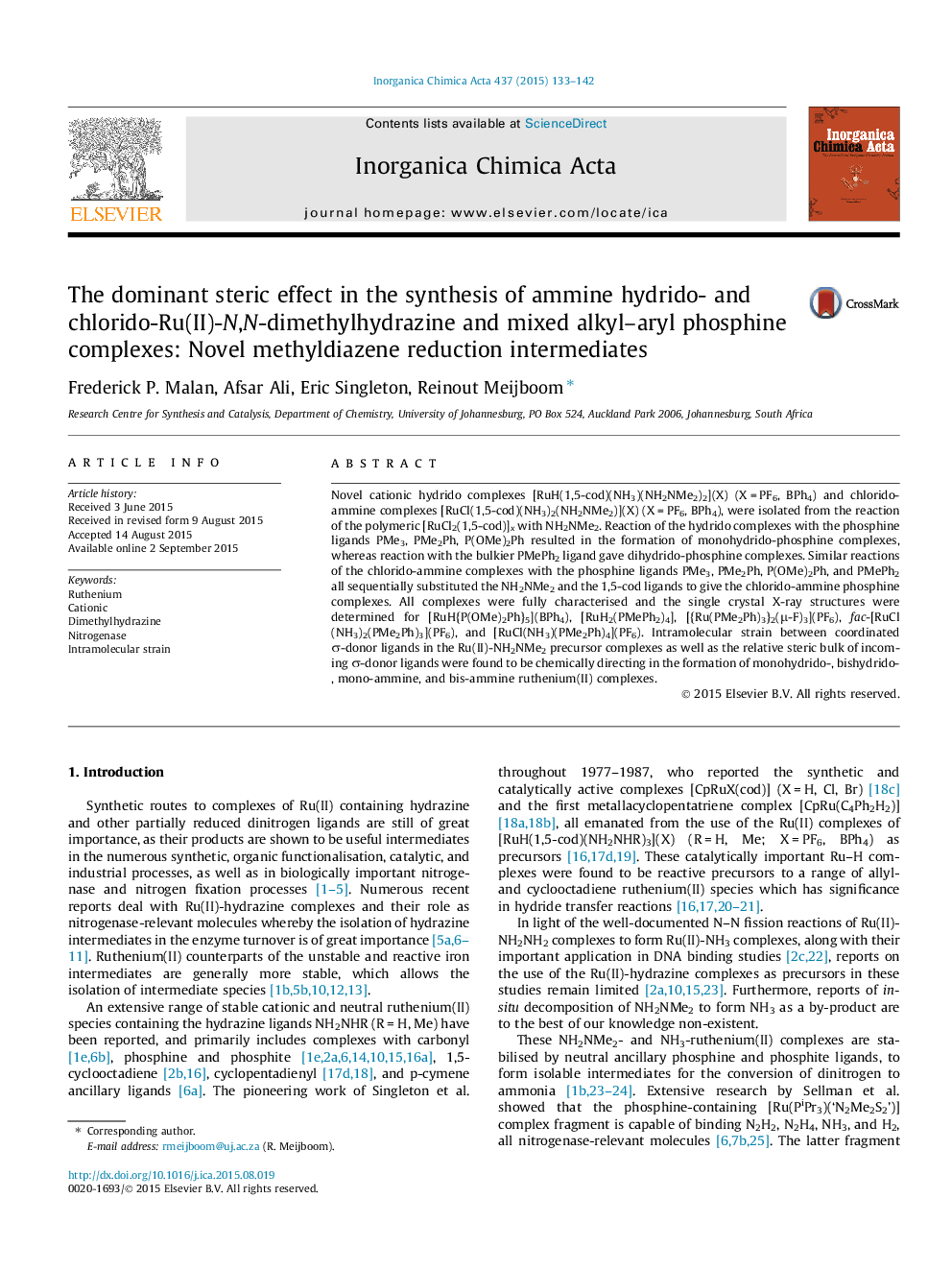| کد مقاله | کد نشریه | سال انتشار | مقاله انگلیسی | نسخه تمام متن |
|---|---|---|---|---|
| 1308800 | 1499152 | 2015 | 10 صفحه PDF | دانلود رایگان |

• Four novel ammine hydrido- and chlorido-NH2NMe2-Ru(II) complexes were synthesised.
• Four novel phosphine hydrido- and chlorido-Ru(II) complexes were isolated from subsequent reactions.
• Hydride resonance changes in the 1H NMR spectrum are studied in the PMe3 addition reaction.
• Steric and electronic properties of ligands were chemo- and regio-directing.
Novel cationic hydrido complexes [RuH(1,5-cod)(NH3)(NH2NMe2)2](X) (X = PF6, BPh4) and chlorido-ammine complexes [RuCl(1,5-cod)(NH3)2(NH2NMe2)](X) (X = PF6, BPh4), were isolated from the reaction of the polymeric [RuCl2(1,5-cod)]x with NH2NMe2. Reaction of the hydrido complexes with the phosphine ligands PMe3, PMe2Ph, P(OMe)2Ph resulted in the formation of monohydrido-phosphine complexes, whereas reaction with the bulkier PMePh2 ligand gave dihydrido-phosphine complexes. Similar reactions of the chlorido-ammine complexes with the phosphine ligands PMe3, PMe2Ph, P(OMe)2Ph, and PMePh2 all sequentially substituted the NH2NMe2 and the 1,5-cod ligands to give the chlorido-ammine phosphine complexes. All complexes were fully characterised and the single crystal X-ray structures were determined for [RuH{P(OMe)2Ph}5](BPh4), [RuH2(PMePh2)4], [{Ru(PMe2Ph)3}2(μ-F)3](PF6), fac-[RuCl(NH3)2(PMe2Ph)3](PF6), and [RuCl(NH3)(PMe2Ph)4](PF6). Intramolecular strain between coordinated σ-donor ligands in the Ru(II)-NH2NMe2 precursor complexes as well as the relative steric bulk of incoming σ-donor ligands were found to be chemically directing in the formation of monohydrido-, bishydrido-, mono-ammine, and bis-ammine ruthenium(II) complexes.
Novel cationic hydrido complexes [RuH(1,5-cod)(NH3)(NH2NMe2)2](X) (X = PF6, BPh4) and chlorido-ammine complexes [RuCl(1,5-cod)(NH3)2(NH2NMe2)](X) (X = PF6, BPh4), were isolated from the reaction of the polymeric [RuCl2(1,5-cod)]x with NH2NMe2. Reaction of the hydrido complexes with the phosphine ligands resulted in the formation of monohydrido- and dihydrido-phosphine complexes. Intramolecular strain between coordinated σ-donor ligands in the Ru(II)-NH2NMe2 precursor complexes as well as the relative steric bulk of incoming σ-donor ligands were found to be chemically directing in the formation of monohydrido-, bishydrido-, mono-ammine, and bis-ammine ruthenium(II) complexes.Figure optionsDownload as PowerPoint slide
Journal: Inorganica Chimica Acta - Volume 437, 1 October 2015, Pages 133–142